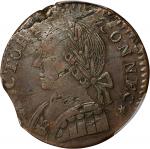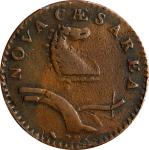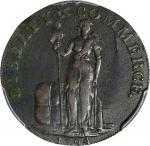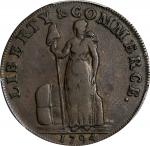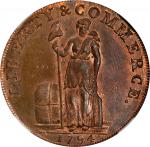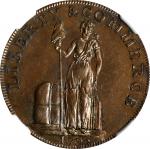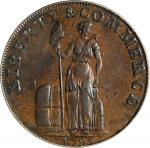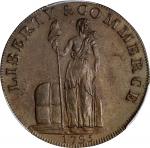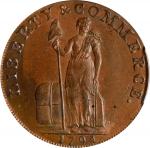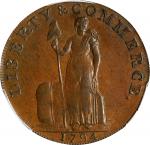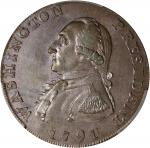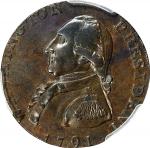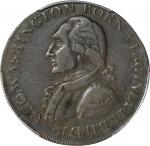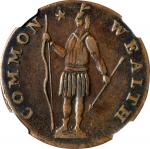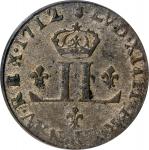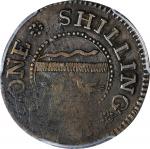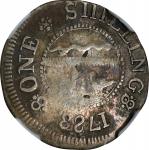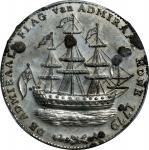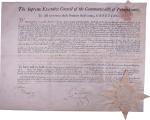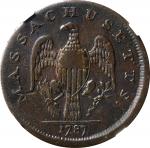1787 Massachusetts Cent. Ryder 2-F, W-6070. Rarity-6. Transposed Arrows. EF-40 (NGC). Very attractive medium olive brown with golden highlights on design elements. The obverse is framed by a nice raised rim from 11 oclock to 5 oclock, while the reverse shows a broad denticles border from 1 oclock to 8 oclock. The word CENT, raised on this reverse but this reverse alone, is worn off, but all other design elements are nicely defined. A few trivial marks are seen, none serious; we note a little struck-through depression at the left wingtip and a small mark at the right side of the exergual line, along with a couple little pits at the Indians profile. The visual appeal is superb for the grade and for the rarity of this piece. <p><p><p>The Transposed Arrows cent stands out among Massachusetts coppers not just for its obvious engravers error, but also in terms of its general styling. Two contracts were entered into by the Commonwealth for the coinage of Massachusetts and the issued coins exhibit two distinct styles overall, mostly in the shape of the S punches. The first contract was with Joseph Callender of Boston, who prepared the earliest and largest number of dies. It is believed that his dies can be distinguished by the more open S style. The second contract was with Joseph Perkins of Newburyport, and it is believed that the heavier, more closed S styles that can be seen on the half cents of 1788 and some of the 1788 cents are attributable to him. This distinction places the Transposed Arrows in the first group, but there is more. This reverse die is the only one with the letters of CENT rendered in relief in the shield, and it is also the only 1787 cent die with a very compact and refined styling to the date. Finally, the eagles tail feathers are uniquely styled as well, in that they only mildly flare outward. These unique features have led to the conclusion that the rare Transposed Arrows reverse was likely the very first reverse die of the entire series, with the discovery of the error having perhaps something to do with the rarity of the issue today.<p><p>Another interesting speculative possibility may have to do with the rarity of this variety. The population of this variety is highly bifurcated: some very well worn pieces, mostly grounders, and one real gem, but not many in the grades in between. There is evidence that the 1787 voyage of the Columbia and Lady Washington from Boston to the Pacific Northwest carried Massachusetts cents (along with Columbia and Washington medals, whose dies were engraved by Joseph Callender of the Massachusetts Mint). The discovery of a worn, holed, and clearly dug example of this variety in a small auction in the Pacific Northwest in November 2000 lends credence to the idea that many or most of these first Massachusetts cents struck were sent on that voyage - with a high grade one perhaps saved by a member of the crew as a souvenir. Interestingly, another holed example appeared in our March 2018 Baltimore sale that was even more worn and corroded. Both holed examples were pierced at the top of the reverse, as if to display the arms of Massachusetts. Seemingly, if these were given out as semi-official trade items with Pacific Northwest natives, that would be the side to focus on.<p><p>There are about 19 known examples of the variety, and the finest known is the Ford gem, from Europe. Recent inquiries have revealed that there is just one gem, not two, so the second gem specimen can be safely removed from the census. After the Ford gem, high grade examples are few: Newmans cleaned AU Details coin, the superb PCGS XF-45 we sold in last summers Syd Martin sale for $66,000, the nice EF specimen from the 1975 Kensington Collection sale now graded PCGS EF-45, the April 2021 Partrick NGC EF-45, and this one. Pickers was a nice VF and was last sold publicly in 1984. After that, the coins are low grade or problematical: the rough Garrett-Partrick coin, the rough Robison-Archangel Fine, the Bushnell-Brand coin, the rim bruised Oechsner coin, the bent AG coin in the ANS, the low grade discovery sold in our Stacks September 2005 sale, and two holed coins mentioned above.<p><p>It appears there are only four that are clearly better than this one (we prefer this example to Newmans). There are really only six that are pretty nice, though a few of the lower grade ones have adequate eye appeal. There hasnt been a nice example discovered out of the woodwork in decades.<p><p>As the signal rarity of the series, and one of the outstanding famous rarities in the entire realm of state coppers, the Transposed Arrows Massachusetts cent has a special place among colonials. That it is not just a rare variety, but an entire distinctive type (with CENT raised instead of incuse), makes it a must-have inclusion in any Massachusetts copper cabinet. This example has been held privately for 40 years, and we are grateful for the opportunity to sell it again. This is its third ever auction appearance, and weve been selected to sell it all three times!<p> PCGS# 299. NGC ID: 2B24. From the collections of the Essex Institute; our sale of the Numismatic Properties of the Essex Institute, February 1975, lot 39; John L. Roper, 2nd Collection; our sale of the John L. Roper, 2nd. Collection, December 1983, lot 220.

